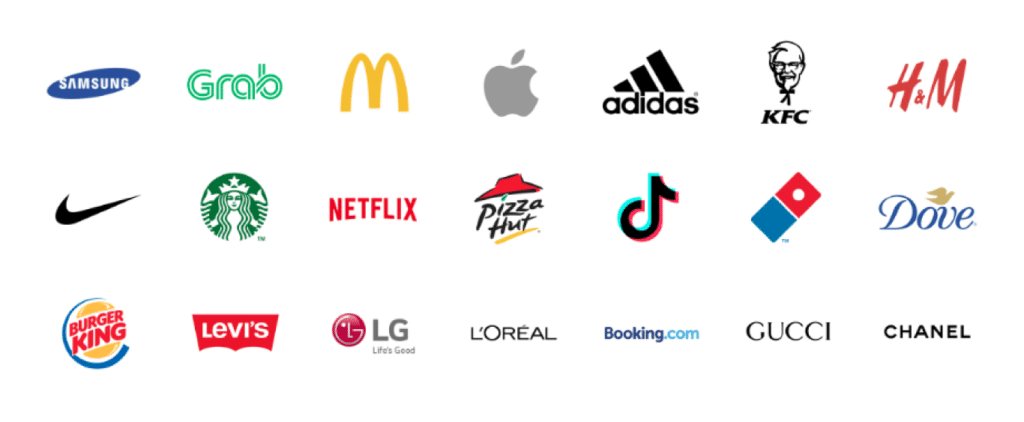- +94 113 487 300
- Email Us
- Mon - Fri: 9:00 - 18:30
Home » Best Digital Marketing Agency Services » Visual Identity Development in Sri Lanka
We believe in the power of a unique yet simple approach to connect brands with people at a glance.
We design brands for digital and physical environments, keeping adaptability in mind and ensuring your brand looks great and is easily identifiable on any platform.
Our cohesive brand identity toolkit, backed by competition analysis and market research, helps your brand stand out and make a lasting impression.
Prominent brands, such as Apple in the tech industry and McDonald’s in the fast food sector, are the epitome of their respective categories.
They serve as benchmarks for comparison and significantly influence consumer preferences, pricing, and product innovation.
Meanwhile, distinctive brands like Tesla in the automobile industry and Liquid Death, a brand of non-alcoholic beverage that primarily sells water, differentiate themselves and avoid direct competition with these leading brands.

Achieving the right balance between centrality and distinctiveness is crucial as it influences brand perception, sales volume, pricing, and profitability. Traditionally, marketers lacked tools to balance these aspects effectively, relying on separate analyses for brand positioning and business performance.
The C-D map is a new approach that directly links a brand’s perceptual position with business outcomes like sales and price. This tool helps managers determine market positions, allocate resources, track performance, and evaluate strategy over time, showing that centrality and distinctiveness can be pursued simultaneously.
Creating a C-D map involves identifying the market and customer segments, conducting surveys to gather data on consumers’ perceptions of a brand’s centrality and distinctiveness, and plotting this data on a 2×2 matrix. The map also captures market performance, with bubble sizes proportional to sales volume, price, or other metrics.
In both the car and beer markets, higher centrality correlates with greater sales volume. For instance, Toyota and Budweiser, the most central brands in their categories, had the highest sales volumes. Conversely, higher distinctiveness correlates with lower sales volumes but allows brands to charge premium prices, as seen with Porsche and Guinness.
These brands enjoy high sales volumes and premium pricing. They must balance maintaining distinctiveness while appealing to a broad audience.
These brands enjoy high sales volumes and premium pricing. They must balance maintaining distinctiveness while appealing to a broad audience.
These brands often follow a “me too” strategy, attracting lower-priced consumers. They may need help to shift their positioning but can survive with low marketing costs.
These niche brands must ensure profitability at low volumes or aim to become more central to increase sales without losing their unique appeal.
Brands can strategically move their position to exploit less crowded market territory or grow sales.
Take Tesla, an unconventional brand that is constantly adapting its position to gain a more central market share, inspiring other peripheral brands to consider a more mainstream approach.
Companies can use the C-D map to ensure their investment in brand strategy pays off by evaluating a brand’s strategic position, assessing the risks and rewards of shifting it and monitoring progress.
Measure the effectiveness of marketing strategies by linking consumer perceptions to business performance.
Identify actual competitors based on consumers’ mental representations of the category.
Measure the effectiveness of marketing strategies by linking consumer perceptions to business performance.
Visualize differences in consumer perceptions and performance across markets to set realistic goals and decide on standardization versus localization.
Monitor how marketing initiatives affect consumer perceptions and brand performance over time.
We start by understanding your target audience, their needs, preferences, and behaviors.
We delve into your brand’s personality and communication style to ensure consistency.
We strategically position your brand in the market, highlighting its unique personality.
We create a cohesive brand identity, including logos, color palettes, and typography.
We ensure your brand identity is effectively deployed across all platforms and mediums.
While some companies have achieved remarkable success with minimal branding, a well-crafted logo and name are just the foundation of a strong brand.
Your brand identity must be adaptable to various platforms, especially digital media. Hence, our designs maintain integrity and visual appeal across all mediums, ensuring consistent brand representation. Train your team with HypeX!

Attention to detail is our hallmark.
Our commitment to perfection in brand identity creation is unwavering. From selecting the right paper stock to suggesting the best printing and laminating methods, we ensure every element is crafted to the highest standard.
We work with vendors who provide quality assurance processes, including extensive guidelines on color rendition, unique treatments like UV varnishing and embossing, and more.
Transparency and keeping you informed are vital principles at HypeX Digital. Here’s a detailed timeline of what to expect
We start with a brand identity development questionnaire to gather initial project details. We can talk about these over coffee or email, whichever works best for you.
We present various logo options and identity materials, including audience analysis, personality study, brand positioning, color palettes, and much more.
Let us know your choice within a week of the presentation where we will submit a comprehensive plan with 3 mood boards for you to select from.
We prepare a comprehensive brand guideline book covering all aspects of your brand, from logo usage to color palettes and typography.
Finally, we hand over all the collateral designs ready for use. This typically takes about four weeks after the details are approved.
If you are looking to find out what our logo means and brand’s core values, the below button will take you right to it.
Happy exploring!
We are just a call or an email away, if we can’t take you in right now we will definitely point you in the right direction. That’s our promise!
10 AM–1:30 AM
10 AM–1:30 AM
10 AM–1:30 AM
10 AM–1:30 AM
10 AM–6:00 PM
Closed
Closed
10 AM–1:30 AM
10 AM–1:30 AM
10 AM–1:30 AM
10 AM–1:30 AM
10 AM–1:30 AM
Closed
Closed
All Rights Reserved | All Wrongs Reversed |